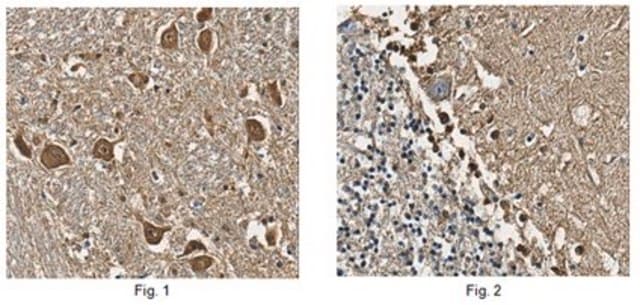EZHS100B
Human S100B ELISA Kit
quantifies S100B in 50 μL cerebrospinal fluid, serum or plasma
Synonym(s):
Protein S100B, S-100 protein beta chain, S100 calcium-binding protein B
About This Item
Recommended Products
product name
Human S100B ELISA, EZHS100B-33K, This Human S100B ELISA kit is to be used for the quantification of human S100B in cerebrospinal fluid, serum & plasma.
Quality Level
species reactivity
human
packaging
kit of 1 × 96 wells
parameter
50 μL sample volume (4hr assay)
assay range
accuracy: 93%
(CSF)
accuracy: 94%
(serum)
sensitivity: 2.7 pg/mL
standard curve range: 2.7-2000 pg/mL
inter-assay cv: <4%
intra-assay cv: <4%
technique(s)
ELISA: suitable
input
sample type cerebrospinal fluid (CSF)
sample type plasma (K2 EDTA)
sample type serum
UniProt accession no.
application(s)
research use
detection method
colorimetric (450nm)
shipped in
wet ice
storage temp.
2-8°C
Related Categories
General description
Specificity
This assay detects S100B in multiple species, including: bovine, hamster, horse, monkey, mouse, pig, rabbit, and rat.
Application
Neuroscience
Other Notes
Disclaimer
Signal Word
Danger
Hazard Statements
Precautionary Statements
Hazard Classifications
Acute Tox. 3 Dermal - Acute Tox. 4 Inhalation - Acute Tox. 4 Oral - Aquatic Chronic 2 - Met. Corr. 1 - Skin Sens. 1
Storage Class Code
6.1C - Combustible acute toxic Cat.3 / toxic compounds or compounds which causing chronic effects
Regulatory Listings
Regulatory Listings are mainly provided for chemical products. Only limited information can be provided here for non-chemical products. No entry means none of the components are listed. It is the user’s obligation to ensure the safe and legal use of the product.
JAN Code
EZHS100B-33K:
Certificates of Analysis (COA)
Search for Certificates of Analysis (COA) by entering the products Lot/Batch Number. Lot and Batch Numbers can be found on a product’s label following the words ‘Lot’ or ‘Batch’.
Already Own This Product?
Find documentation for the products that you have recently purchased in the Document Library.
Our team of scientists has experience in all areas of research including Life Science, Material Science, Chemical Synthesis, Chromatography, Analytical and many others.
Contact Technical Service











